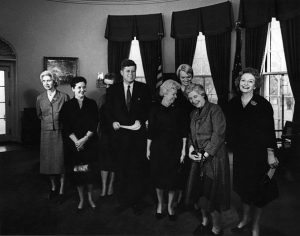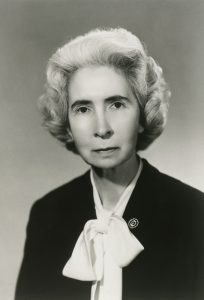It’s no secret that women are underrepresented in the realm of U.S. patent holders. A briefing paper released last summer by the Institute for Women’s Policy Research (IWPR) indicated that less than 20 percent of U.S. patents list a female inventor. Further, women constitute only 7 percent of primary inventors on U.S. patents. This issue of underrepresentation isn’t simply one of economic opportunity; indeed, there is reason to believe that a higher percentage of male inventors results in fewer innovations targeted at issues facing women.
This March 4th, however, gives us the occasion to champion a female inventor who will be included in the 2017 class of inductees into the National Inventors Hall of Fame. 65 years ago today, American chemical researcher Allene Jeanes was issued a patent for a polysaccharide innovation which had major implications for the U.S. military, helping to save the lives of soldiers injured on the front lines of the Korean War.
If this were the only contribution made by Jeanes to the body of chemical science and engineering knowledge, that might well have been enough to earn her inclusion into the National Inventors Hall of Fame. However, Jeanes is also the pioneer behind another chemical innovation involving polysaccharides, discovering an emulsifier and food stabilizer, which is found in the ingredient list of a great deal of processed foods available in grocery stores today. The career of Allene Jeanes covers some of the most important innovations spurred on by the U.S. Department of Agriculture (USDA) and could serve as a source of inspiration for the female innovators of today.
Dextran: How Rotten Root Beer Saved the Lives of Korean War Soldiers
Allene Rosalind Jeanes was born in Waco, TX on July 19th, 1906, and by all accounts benefitted from a course of science education which was not widely available to women during her day. She graduated from Baylor University in 1928 with a bachelor’s degree in chemistry and received her master’s degree in organic chemistry the following year from the University of California at Berkeley. In her first years out of college, Jeanes worked as a science teacher at the collegiate level before returning to her studies and earning her Ph.D in organic chemistry from the University of Illinois in 1938, where she studied with American organic chemist Roger Adams.
After receiving her doctoral degree, Jeanes began working as a scientific researcher for the federal government, first serving with the National Institutes of Health (NIH). She worked in the laboratory of Claude S. Hudson, a renowned chemist in the area of carbohydrates, and her work focused on research into corn carbohydrates. She also served a quick stint with the National Bureau of Standards before she joined the USDA’s Northern Regional Research Lab (NRRL) in Peoria, IL, and it was here where she would make her greatest contributions to the science behind producing useful polysaccharides.

President John F. Kennedy meets with recipients of the 1962 Federal Women’s Award, Allene Jeanes is first on the left. Public domain.
Given that the USDA was actually established as a division within the U.S. Patent Office in 1839, it’s not surprising that the USDA’s research laboratories would be focused on innovation even a century after the department was first formed. The NRRL was particularly focused on finding new uses for corn, wheat and agricultural waste byproducts and Jeanes studies were largely interested in the production of polymers and the hydrolysis of starch to glucose. One issue that her early research turned up was the conversion of starch to isomaltose, a bitter agent which was undesirable for corn-based sweeteners, instead of glucose. Sources of isomaltose were scarce, however, and this limited her research.
It would take a contaminated batch of root beer from a soda company in Peoria for Jeanes to find the isomaltose she needed to advance her research. The root beer, contaminated with bacteria and described as “ropy,” was producing a bacterial slime known as dextran, a complex branched glucan which could be hydrolyzed to isomaltose. During the 1940s, dextran was increasingly a subject of focus among Swiss and British scientists who were exploring the possibility of dextran as a blood volume expander. While dextran couldn’t transport oxygen to cells in the way that red blood cells can, it was thought that it could potentially save the lives of victims suffering massive blood loss by restoring electrolytes and maintaining blood pressure.
Almost accidentally, Jeanes and the research staff at the NRRL thus became America’s top researchers in a growing field of medical study. When the United States entered the Korean War in 1950, Jeanes proposed a high-priority project which would develop dextran into a potential blood plasma extender and overcome issues with anaphylactic shock and inconsistent preparations. The dextran produced from the strain and techniques developed by Jeanes and a team of nearly 80 scientists and technicians stayed viable longer than blood plasma without refrigeration, an issue that hampered the treatment of wounded soldiers during World War II. It was also much cheaper to produce than plasma, capable of being sterilized to reduce the risk of infection and could keep a massive blood loss victim alive longer, extending the time in which they could receive a life-saving blood transfusion. Dextran was approved for military use in 1950 and by the end of the Korean War it was the main initial fluid resuscitation agent used by the military to treat shock.
Jeanes’ contributions to dextran production is reflected in U.S. Patent No. 2587623, titled Acylation of Dextran in Formamide and one of the two patents for which Jeanes is inducted into the National Inventors Hall of Fame. It claimed the method of dissolving dextran in formamide and then acetylating the dissolved dextran with acetic anhydride in the presence of pyridine at temperatures ranging from 15°C to 30°C to produce dextran triacetate which is soluble in tetrachloroethane. The method claimed here produces highly viable dextran which is soluble in commercially available organic solvents, which can reduce dextran’s tendency to decompose, doesn’t require external heat for the esterification process and has a high resistance to chemical and physical attack.
Xanthan Gum: Used for Just About Everything Except for Chewing
After dextran, Jeanes continued her work in the research and development of complex carbohydrates and her next significant contribution to science would be a production process for a substance to replace plant gums. One of the research missions of the NRRL was to develop products which could be produced domestically in order to reduce the reliance of the United States on foreign sources of agricultural products. Plant gums, used as a binder or thickener in certain food products while also having industrial applications, was a valuable import which came from regions in Africa, Asia and the Middle East which at that time were unstable.
Because dextran was a bacterial slime, it had properties similar to these plant gums and Jeanes’ interest was piqued. She and another team of researchers set out to create a microbial gum which could reduce American reliance on imported plant gum. Eventually, her team discovered that the bacterium Xanthomonas campestris was capable of converting large amounts of glucose into xanthan gum, a substance which showed the capacity to greatly increase the viscosity of liquids even at very low quantities. For instance, adding xanthan gum to salad dressing thickens the liquid elements to keep the mixture homogeneous and help it stick to vegetables but xanthan thins when shaken, which is why it’s easier to pour salad dressing after shaking it. The substance was first commercialized by the Kelco Corporation in the 1960s and today it can be found in salad dressings, sauces and other food products where it can substitute eggs. It’s thickening properties also make it useful for toothpaste, improving oil drilling by causing solids to float to the top of drilling mud and in cosmetic products to stabilize oil in oil-in-water emulsions.
In September 1961, Jeanes was listed as the primary inventor on U.S. Patent No. 3000790, titled Method of Producing an Atypically Salt-Responsive Alkali-Deacetylated Polysaccharide. It disclosed a method of preparing the substantially deacetylated derivative of the polymeric polysaccharide B-1459 by dissolving 0.67 parts of B-1459 in 100 parts of air-free water containing potassium chloride, vigorously stirring in 34 parts of 0.20 N potassium hydroxide solution, maintaining that mixture at a temperature of 25°C for two hours under nitrogen, adjusting the pH level to neutral and then precipitating the deacetylated polysaccharide by adding methanol. This innovation overcame disadvantages of known polyelectrolytes, like gum tragacanth, by producing a polysaccharide which exhibited a higher viscosity in the presence of salts.
The pioneering work of Allene Jeanes led to a great deal of recognition during her career beginning in 1956 when she was named a recipient of both the USDA Distinguished Service Award, the first woman to receive this recognition, as well as the Francis P. Garvan-John M. Olin Medal from the American Chemical Society. In 1962, she received the Federal Women’s Service Award from the U.S. Civil Service Commission. In 1968, Jeanes and the team behind xanthan gum production received the USDA Superior Service Award distinction for their contributions. In 1976, the same year that Jeanes retired from the NRRL, both the NRRL and Kelco Corporation were presented with the Food Technology Industrial Achievement Award from the Institute of Food Technologists. In the nearly two decades between her retirement and her death in December 1995, she continued to serve as a mentor for NRRL researchers and collaborated on projects. In 1999, Jeanes was inducted into the USDA’s Agriculture Research Service Science Hall of Fame, one of the few female scientists to achieve such an honor.

![[IPWatchdog Logo]](https://ipwatchdog.com/wp-content/themes/IPWatchdog%20-%202023/assets/images/temp/logo-small@2x.png)


![[Advertisement]](https://ipwatchdog.com/wp-content/uploads/2024/03/IP-Copilot-Apr-16-2024-sidebar-700x500-scaled-1.jpeg)
![[Advertisement]](https://ipwatchdog.com/wp-content/uploads/2024/04/Patent-Litigation-Masters-2024-sidebar-early-bird-ends-Apr-21-last-chance-700x500-1.jpg)

![[Advertisement]](https://ipwatchdog.com/wp-content/uploads/2021/12/WEBINAR-336-x-280-px.png)
![[Advertisement]](https://ipwatchdog.com/wp-content/uploads/2021/12/2021-Patent-Practice-on-Demand-recorded-Feb-2021-336-x-280.jpg)
![[Advertisement]](https://ipwatchdog.com/wp-content/uploads/2021/12/Ad-4-The-Invent-Patent-System™.png)







Join the Discussion
One comment so far.
Paul Cole
March 6, 2017 11:27 amMany thanks for reviving the memory of this brilliant and hard-working person.